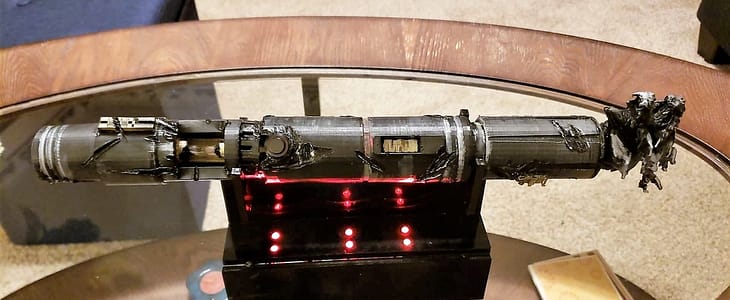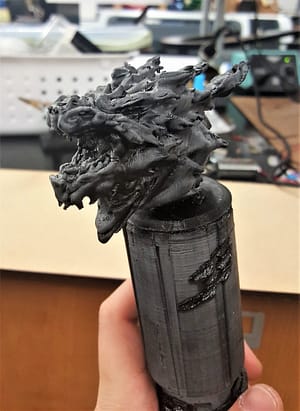
I love to learn. I think that’s an inherent trait in writers. We learn and then we write to sort through that knowledge. So this was a fun exercise for me. I decided to learn a bit more about something that has always intrigued and perplexed me: 3D printing.
To learn about what 3D printing is, and how it works, check out this video by Mashable Explains.
3D Printing and Guns
The first time I heard about 3D printing, it was in a news report about the potential for 3D printing to be used to make parts of a gun, which could easily be passed through security checkpoints, undetected, and later reassembled on the plane and used for terrorism.
Here’s a more recent article highlighting the concerns about guns created using 3D printing.

3D Printing is becoming very accessible
I know several people who have worked with 3D printers. One of them is my friend, Tommy Pham. Tommy is an amazing artist. The 1st 3D printing project I saw of his was the hilt of a lightsaber.
Tommy made his hilt using 3D printing technology. (Pics of the hilt)

He also created a model of Omega, a character from the RPG game, Fortnite by Epic Games. Then he painted it in the style Marvel uses for their superheroes.
“The whole orange color is the Material used. The black stuff covers him called Support… it helps the Material stays where it supposed to be. And I painted him afterward. Called Post-process stage.” (sic)
In need of a kidney?
If you needed to have a kidney transplant, you would likely be placed on a transplant list. You would then wait until a suitable kidney could be found. Meanwhile, you’d get dialysis to keep you alive. If you do receive a kidney, it could be from a deceased donor. These are people who have indicated they would like to donate their organs after they die. There are certain requirements for deceased donor’s organs to qualify as transplantable.
You could also get a kidney from a living donor. These are perfectly healthy people who donate one of their kidneys to save the life of a loved one—or even a complete stranger. There also are currently over 50,000 living donors who have already donated their kidneys to people facing kidney failure. A transplant from a living donor is preferable for many reasons, including the fact that the donated kidney typically lasts twice as long as those from a deceased donor.
Yet, there are many things to consider when it comes to living donors[1]:
- Lost wages for the donor
- Post-operative complications
- Recovery time
- The cost of medical complications for the donor that won’t be covered by the recipient’s insurance
- Travel and lodging expenses for the donor aren’t always reimbursed
- Legal representation is sometimes needed
- It’s important to get a good biological match between the donor and recipient
- The age of the donor can affect the outcome
- How long the recipient was on dialysis will affect the outcome
Donating a kidney (or any organ) is a rewarding and heroic thing to do, whether as a living donor or after your death. But, there are still many people waiting for a kidney, extending the time they spend on dialysis. This can have a major impact on their lives. What if there was another option?
Bio-3D-Printing
One of the latest, and perhaps most incredible ways of utilizing 3D printing is to save a life. Researchers are working on 3D printing human organs, including kidneys. Kidneys are particularly needed because 90% of recipients on transplant waiting lists are waiting for a kidney. Check out this moving TED Talk about printing a human kidney.
As I broadened my knowledge on the topic of 3D printing, I was able to catch up with an old friend and learn about new technology. Not bad for some light learning. I challenge you to broaden your knowledge on a subject you’d like to learn more about. What will you look into? Please share in the comments below.
The A to Z Blogging Challenge
 I’m doing double duty this month during the A to Z Blogging Challenge. Here at Heather Erickson Author/Writer/Speaker, I will share ideas for “Thinking Creatively.” I’ll also be doing the challenge at Facing Cancer with Grace, where I will focus on “Avoiding Burnout.” I hope you’ll visit me at both sites. While you’re here, sign up for my email list. Today’s post is K is for Broaden Your Knowledge.
I’m doing double duty this month during the A to Z Blogging Challenge. Here at Heather Erickson Author/Writer/Speaker, I will share ideas for “Thinking Creatively.” I’ll also be doing the challenge at Facing Cancer with Grace, where I will focus on “Avoiding Burnout.” I hope you’ll visit me at both sites. While you’re here, sign up for my email list. Today’s post is K is for Broaden Your Knowledge.
Tunnel vision can stifle creativity. That’s why it took an outsider like Apple to revolutionize an entrenched mobile phone industry with the iPhone. So spend 30 minutes today exploring outside your area of expertise to enrich your mind and expand your knowledge.
- What new trends are emerging?
- What new topics could you explore?
- How can you integrate this new knowledge?
- How can you keep your finger on the pulse?
What Are YOUR Thoughts?
I’d love to hear in the comment section, below. I appreciate my readers as well as the writing community. To show that appreciation, I use Comment Luv. Just leave a comment below and your latest post will get a link next to it. Thank you!
About Heather Erickson
I am an author, writer, and speaker and homeschooling mom of 3. Since doctors diagnosed my husband, Dan with stage IV lung cancer in 2012, I’ve focused my writing and speaking on helping cancer patients and their families advocate for themselves and live life to the fullest, in spite of their illness. My goal is to help people face cancer with grace. My books are available at Amazon.com:
Facing Cancer as a Friend: How to Support Someone Who Has Cancer
Facing Cancer as a Parent: Helping Your Children Cope with Your Cancer
I also blog about living with cancer at Facing Cancer with Grace.
Footnotes:
[1] Taoti Enterprises International. “Living Donors.” Home Page – National Kidney Registry – Facilitating Living Donor Transplants, www.kidneyregistry.org/living_donors.php?cookie=1.

6 comments on “K is for: broaden Your Knowledge (3D Printing)”
Liz A.
April 12, 2019 at 12:52 pmOne of the schools I sub at had a 3D printer. (The continuation high school.) The teacher makes some interesting things with it. I did hear they want to “print” organs. That would be awesome.
heatherericksonauthor
April 19, 2019 at 10:18 pmHi Liz, When I was in school, technology meant Oregon trail on an Apple computer. It’s amazing the cool things that kids get to learn. In our area, medical technology is king. We really benefit from this innovation.
John Holton
April 12, 2019 at 3:48 pmAfter reading this, I think using a 3D printer to print a kidney would be really great. The rejection rate would be really low, wouldn’t it?
heatherericksonauthor
April 19, 2019 at 10:29 pmHi John. I hadn’t even thought about the benefit of not rejecting the 3D printed kidney. All the more reason. And hopefully, it will kick the organ black market in the teeth.
Patricia Lynne aka Patricia Josephine
April 13, 2019 at 5:15 pmThat would be amazing if they can figure out how to print a kidney. So many people would be helped by it.
heatherericksonauthor
April 19, 2019 at 10:34 pmHi Patricia. And it would be only the beginning. It would be really interesting to study medical ethics with all of these innovations happening.